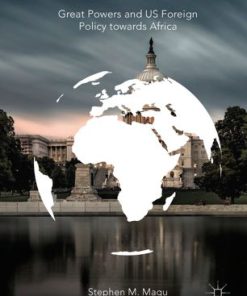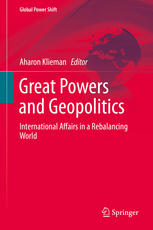Great Powers Weak States and Insurgency Explaining Internal Threat Alliances 1st Edition by Patrick 3319474197 9783319474199
$50.00 Original price was: $50.00.$25.00Current price is: $25.00.
Great Powers Weak States and Insurgency Explaining Internal Threat Alliances 1st Edition Patrick Quirk – Ebook Instant Download/Delivery ISBN(s): 9783319474199, 3319474197

Product details:
- ISBN 10: 3319474197
- ISBN 13: 9783319474199
- Author: Patrick
This book offers an original and theoretically rich examination into the dynamics of alliances that great powers and weak states form to defeat threats, such as rebellion or insurgency, within the smaller state’s borders. The author examines contemporary examples of such “internal threat alliances,” including Russia’s collaboration with Syria’s Assad regime to defeat anti-government rebels and U.S. cooperation with Afghanistan’s ruling political elite to combat the Taliban. In each case, the weaker state’s leadership wanted to remain in power while the great power sought to safeguard its interests linked to the regime’s stability. The book adds to International Relations (IR) theory by presenting a distinct conceptual framework that explains why internal threat alliances form, why some are more cohesive than others, and why some are effective while others are not. It thus promises to be of interest to IR scholars and students working in the areas of security studies, alliance dynamics, political violence, and civil war, but also to policy-makers grappling with how to salvage interests, such as access to natural resources or regional stability, imperiled by violence in weak states.
Table of contents:
Chapter 1: Internal Threat Alliances: A New Conceptual Framework
Theoretical and Policy Relevance
The Argument
Traditional Military Alliances
Cooperation to Balance External Threats
Alliance Formation: External Threat to the National Interest
Bandwagoning: Either Balance or Bandwagon
Alliance Effectiveness: Sufficient Resources to Thwart a Common Enemy
Gap in the Literature
The Argument
Internal Threat Alliances: A New Conceptual Framework
Alliance Formation
Why the Weak State’s Leaders Align
Why the Great Power Aligns
Why and When Actors Bandwagon
Alliance Effectiveness: Sufficient Resources and Ability to Curb Subnational Bandwagoning
Lessons for Policy
Conclusions
Roadmap for the Remainder of the Book
Notes
Chapter 2: US–Colombia Internal Threat Alliance (1980–2010)
US–Colombia Internal Threat Alliance (1980–2010): Historical Overview
From the “Brink of Collapse” to “Turning the Tide”
Characteristics of the Colombian State: Internal Fragmentation, Multiple Actors, and Competing In
Alliance Formation
Profile of the Internal Threat: Insurgents and Narco-traffickers Imperiling Regime Survival and
Evolution of the “Narco-Guerrilla” Threat
Why the USA and Colombia Aligned: To Safeguard the Regime and US Interests Associated With It
External and Internal Threats (1981–1989): Reagan [USA] and Turbay, Betancur [Colombia]
The Shift to Internal Threat Alliance (1989–1993): Bush [US] and Barco [Colombia]
Bandwagoning
Bandwagoning to Survive: Defections and Diverting Alliance Resources
Bandwagoning for Power and Patron: Self-Interest Over National Interest
Circumventing Bandwagoning Regime Actors
Alliance Effectiveness
“To the Brink of Collapse”: Low Alliance Effectiveness (1980–1998)
Betancur (1982–1986): Close Alignment Morphs from Political Liability to Asset
Barco (1986–1990): Political Interests Push Regime/USA into “Golden Embrace”
Gaviria (1990–1994): Cooperation Increases to Quash “Narco-Terrorism Plague”
Samper (1994–1998): Central Regime Bandwagons, Sends Alliance into Tailspin
Alliance Effectiveness Remains Low as Samper Steps Down
“Turning the Tide”: Higher Alliance Effectiveness (1998–2010)
Uribe (2002–2010): Regime Needs Resources to Secure (Unprecedented) Re-election
Alliance Effectiveness Soars Under Pastrana, Uribe
Case Conclusions
Chapter 3: US–Afghanistan Internal Threat Alliance (2001–2012)
US–Afghanistan Internal Threat Alliance (2001–2012): Historical Overview
Characteristics of the Afghan State: Internal Fragmentation, Multiple Actors, and Competing Inter
Alliance Formation
Profile of the Internal Threat: Insurgents Imperiling Regime Survival and US Interests
The Insurgent Threat
Why the USA and Afghanistan Aligned: To Safeguard the Regime and US Interests Associated With
George W. Bush (2001–2009) and Hamid Karzai: Regime Survival to Balance Terrorism
Barack H. Obama (2008–2012) and Hamid Karzai: Regime Survival to Balance Terrorism
Bandwagoning
Bandwagoning to Survive: Defections and Diverting Alliance Resources
Bandwagoning for Profit: Switching to the Winning Side to Share in Spoils of Victory
“Green-On-Blue” Bandwagoning
Bandwagoning for Power and Patron: Self-Interest over National Interest
Bandwagoning Enables bin Laden’s Escape
“Warlords” Bandwagon to Safeguard Subnational Fiefdoms
Ministries of Interior (and Police) and Defense (and Army) Bandwagoning
Powerful Provincial Figures Bandwagon to Expand Power, Influence
Alliance Effectiveness
Karzai and Bush, Early Days: Regime Priorities Smooth Path for Strategy Agreement
Karzai’s Desire to Consolidate Authority Drives Him Closer to Bush (2004–2006)
Karzai’s Political Interests Undercut Alliance Gains (2006–2008)
Karzai and Obama: “Bandwagoning for Ballots” Drives Allies Apart
U.S. Tries to “Make Nice,” but Karzai Continues to Bandwagon
Karzai’s “Pendulum Approach” to Curbing Bandwagoning
“Feathering His Own Nest”: Karzai Diverts Resources to Bolster Power
Alliance Effectiveness Remains Low as Obama’s First Term Ends
Case Conclusions
Chapter 4: Russia–Syria Internal Threat Alliance (2010–2016)
Russia–Syria Internal Threat Alliance (2010–2016): Historical Overview
Characteristics of the Syrian State: Sectarian Tension, Fragmented Opposition, and Regional and
Alliance Formation
Profile of the Internal Threat: Anti-regime Forces Threaten Russian Interests
Evolution of the Internal Threat
Free Syrian Army
Islamic Front
Jabhat al-Nusra
ISIS/ISIL
Why Russia and Syria Aligned: To Safeguard the Regime and Russian Interests Associated With It
Vladimir Putin and Bashar al-Assad: Regime Survival to Serve Geopolitical Interests
Vladimir Putin and Bashar al-Assad: Regime Survival and Commercial Interests
Vladimir Putin and Bashar al-Assad: Regime Survival and Strategic Military Interests
Bandwagoning
Bandwagoning to Survive: Defections for Self-Preservation
Bandwagoning for Profit: Switching to the “Winning” Side to Share in Spoils of Victory
Bandwagoning for Patron: Defections to Protect Fellow Sunnis; Regime Actors Funnel Arms for Their
Alliance Effectiveness
Effective Efforts to Limit Bandwagoning: Raising the Costs of Defection, Paying for Loyalty
Shifting the Balance of Power: Russian Military Resources Increase Alliance Effectiveness
Alliance Effectiveness Remains High as Conflict Enters Its Fifth Year
Case Conclusions
Notes
Chapter 5: Conclusions
People also search:
great powers war
great power struggle
strong states weaken a nation
strong states vs weak states
weak states examples
You may also like…
Politics & Philosophy - Government & Politics
Great Powers and US Foreign Policy towards Africa Stephen M. Magu
Jurisprudence & Law - Criminal Law & Procedure
Politics & Philosophy
Politics & Philosophy
Cookbooks
Politics & Philosophy - Anthropology
Oil and the Great Powers: Britain and Germany, 1914 to 1945 First Edition Anand Toprani












